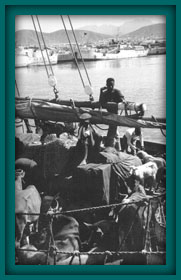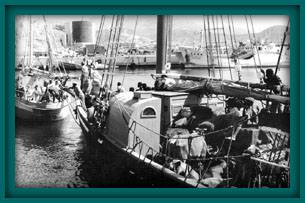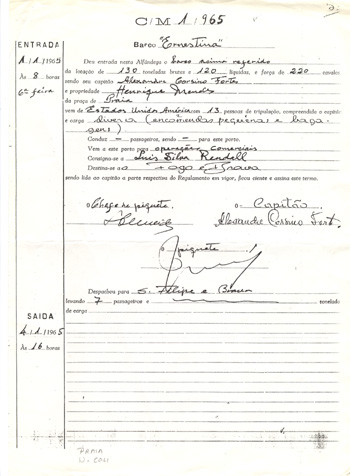| After
returning to Cape Verde, the Ernestina was kept
busy carrying cargo and passengers between Mindelo, Fogo,
Brava and Praia with frequent visits to Sol, Sao Nicolau,
and Santo Antao. On a typical trip from Mindelo, Sao
Vicente to Brava she would carry flour, sugar, margarine,
soap, glasses, soda, paper, biscuits, beer, juice, and
fireworks for the Fourth of July; to Fogo with oil, rice,
sugar, lard, baking powder, matches, custard, tobacco,
nails, roof tiles, and doors and cushions for the
Catholic Mission. From Fogo she would sail on to Praia
carrying wine, beer, peanuts, soap and gasoline and then
return back to St. Vincente with maize, potatoes, eggs,
pork, hens, and turkeys.
Carrying tons of pozzolana*, oil drums, lumber, and sacks of grain took their toll on the Ernestina. Her stern began to droop and her deck was worn down by the frequent loading and unloading of cargo. Henrique Mendes could no longer afford to keep her up; however, she was vital for inter-island communication and transportation. In 1963 Luiz Silva Randall, Governor of the islands and son-in-law of Henrique Mendes, put up most of the $25,000 spent on repairs to the ship thereby acquiring ownership of the vessel.
Alberto Lopes, a local shipper in the islands acquired the Ernestina in 1967 and from the beginning had a lot of trouble with her. In 1970, water was entering next to the propeller shaft and Alberto had to have the vessel overhauled. A new propeller was fitted and the shafting realigned. In October, he made a trip to Sao Antao and anchored at Paul. The motor broke and he had to navigate back to Mindelo with only sail power and his skill. In 1971, her mainsail was torn to shreds in a stiff breeze off Sao Nicolau and she had to be towed to Sao Vicente by the MV Cabo Verde. The vessel was again slipped for drying out and general repairs and maintenance. Henrique Mendes passed away in Fogo on October 14, 1970 at the age of 90 years. He was born January 20, 1880. *In 91 B.C. The Romans discovered that pozzolana, volcanic ash from Puteoli, near Naples, makes excellent concrete that will set and keep it's integrity even under fresh or salt water. It is what built the Coliseum and the Aqueducts still standing today. |
|
 The merchants usually
accompanied their goods and there were always plenty of
passengers aboard the Ernestina. The Ernestina
also collected laborers contracted for the coffee
plantations of Sao Tome. On one particular voyage she
called at Ponte do Sol, Janela, Paul, Porto Novo (S.
Antao), then sailed on to Sao Nicolau and Praia. She
carried 110 "contractos" or contract laborers
bound for the equatorial heat of Sao Tome. On another
trip she returned with 169 of these laborers to Sao
Filippe. Seventy-one soldiers and fifty-three passengers
are recorded on board the Ernestina for a voyage
from Sao Vicente to Praia in 1967. In 1968, the Bishop of
Cape Verde sent used clothes to the mission in Fogo.
The merchants usually
accompanied their goods and there were always plenty of
passengers aboard the Ernestina. The Ernestina
also collected laborers contracted for the coffee
plantations of Sao Tome. On one particular voyage she
called at Ponte do Sol, Janela, Paul, Porto Novo (S.
Antao), then sailed on to Sao Nicolau and Praia. She
carried 110 "contractos" or contract laborers
bound for the equatorial heat of Sao Tome. On another
trip she returned with 169 of these laborers to Sao
Filippe. Seventy-one soldiers and fifty-three passengers
are recorded on board the Ernestina for a voyage
from Sao Vicente to Praia in 1967. In 1968, the Bishop of
Cape Verde sent used clothes to the mission in Fogo. In the late sixties, the Ernestina was still
making a hundred trips a year but was getting slower. It
took Capt. Raimundo Nonato Brito only 24 hours to sail
from Porto Grande, Mindelo (S. Vicente) to Vale dos
Cavaleiros, San Filippe (Fogo) on December 28, 1969 with
thirty-eight tons of general cargo; it was taking Pedro
Evora two days to complete the same journey a few years
later. Her rigging was worn and her engine frequently
broke down.
In the late sixties, the Ernestina was still
making a hundred trips a year but was getting slower. It
took Capt. Raimundo Nonato Brito only 24 hours to sail
from Porto Grande, Mindelo (S. Vicente) to Vale dos
Cavaleiros, San Filippe (Fogo) on December 28, 1969 with
thirty-eight tons of general cargo; it was taking Pedro
Evora two days to complete the same journey a few years
later. Her rigging was worn and her engine frequently
broke down.